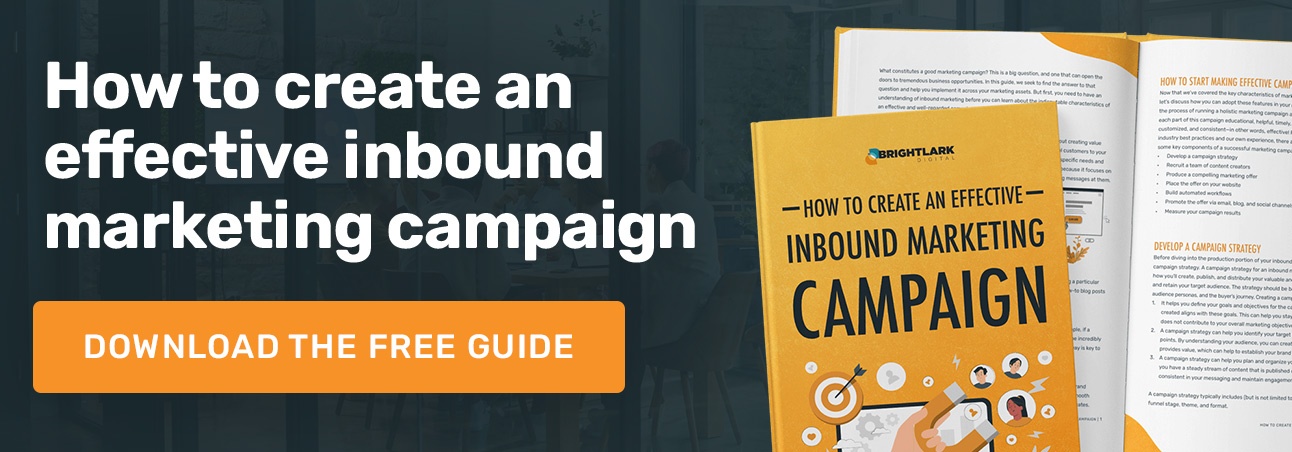What makes inbound marketing so successful?

Are you tired of marketing strategies that don't resonate with your target audience? Inbound marketing might be the solution you've been searching for.
Digital marketing has always been about telling the most powerful story with a purpose, in order to gain the attention of viewers. Inbound marketing takes this idea one step further by placing customers at the center of that story.
Inbound marketing is a thoughtful approach that provides tailored solutions in response to the unique needs of your target audience. These focused marketing campaigns offer relevant information that convinces your readers while promoting trust.
Our team at Brightlark Digital has applied inbound marketing across clients of diverse backgrounds, with largely positive responses. Using an inbound marketing strategy, you can confidently guide readers toward a CTA and nurture long-term customer relationships. Let us show you the proven steps for success and how you can step up your inbound marketing game.
What is inbound marketing?
At its core, inbound marketing is a type of business strategy with a clearly defined target audience. Unlike outbound marketing, which presents general content, inbound marketing tailors the approach according to audience needs. Effective examples of inbound marketing include personalized social media campaigns, SEO-focused articles, and other strategic content that generates high levels of brand awareness.
Your business will experience less resistance with inbound marketing compared to outbound alternatives because your audience won’t feel like they have been bombarded by excessive or intrusive content. Essentially, the target audience (i.e., customers, partners, and prospects) actively seeks your business offerings, so it’s easier to “speak their language” and find common ground.
So what makes inbound marketing so successful?
Content is in the driver's seat
Content plays a crucial role in inbound marketing because it is what attracts and engages potential customers. Inbound marketing is all about creating valuable and informative content that addresses the needs and pain points of your target audience.
Helpful content can establish your brand as a thought leader in your industry and build trust with potential customers. Even if your audience isn't quite ready to buy yet, your brand is showing up to help in other ways. The idea is that when your audience gets to buyer's mode, your brand will be top-of-mind. Content can come in many forms, such as blog posts, videos, eBooks, social media posts, and more, depending on the content topic, the purpose, and of course, your audience.
By creating high-quality content that resonates with your target audience, you can build long-term relationships with customers and generate sustainable growth for your business.
A customer-centric approach
Inbound marketing and traditional marketing differ significantly in their approach and execution. Traditional marketing methods typically involve interrupting consumers' daily lives with ads that they may or may not be interested in. This includes TV commercials, billboards, print ads, and cold-calling.
In contrast, inbound marketing seeks to attract customers by providing valuable content that they are actively seeking out. Inbound marketing also focuses on building relationships with customers through personalized messaging and interactions. Furthermore, traditional marketing is typically more difficult to track and measure, whereas inbound marketing uses data analytics and marketing automation to optimize and refine strategies.
Overall, while traditional marketing methods can still be effective, inbound marketing has proven to be a more cost-effective and targeted approach in today's digital age.
The reliance on data
Inbound marketing is heavily reliant on data, as it allows marketers to track and analyze the success of their campaigns and make informed decisions to optimize their strategies.
There are many different types of data that can be used in inbound marketing, such as website analytics, social media metrics, and customer demographics. By collecting and analyzing this data, marketers can better understand their target audience and tailor their content and messaging accordingly.
Additionally, marketing automation tools can help streamline the data collection and analysis process, allowing marketers to focus on strategy development and execution. By utilizing the power of data and automation, inbound marketers can create more effective and efficient campaigns that generate better results.
How do you implement an inbound marketing strategy?
Our team of marketing experts have identified five proven steps to launch and optimize your inbound marketing efforts.
An effective inbound marketing strategy often begins with understanding your target demographic and the challenges that they face. Doing so provides a clear vantage point that guides the rest of your inbound marketing strategy.
Next, you’ll need to engage your target audience by creating meaningful content in response to your audience's pain points. Leveraging SEO and social media platforms can help you deliver your content with greater efficiency. As a result, you can establish your brand as a committed solution provider that prioritizes customer needs every time.
Also, it is important to note that inbound marketing isn’t a destination but an ongoing journey. Your team needs to constantly nurture your leads through quality support and assistance that fosters brand loyalty. And finally, you'll need a reliable method of measuring the results of your inbound marketing campaigns so you can achieve repeated success across diverse scenarios. We break down the five steps to help you establish a strong inbound marketing strategy from the get-go.
1. Understand your target audience
Your target audience is the group of people most likely to complete a transaction with your brand. Failing to identify your target audience often leads to ineffective marketing strategies where the underlying message might fall on deaf ears. Successful examples of inbound marketing rely on effectively reaching out to a target or niche crowd.
You can categorize your target audience based on factors such as their purchase intent (how likely someone would purchase from your brand), location, and frequency of online engagement. We discovered that there’s much to learn from reviewing existing customer bases, which can help establish insightful buyer trends. Google Analytics can provide the essential data required to effectively identify your target crowds.
It is also crucial to conduct deep market and competitor analyses. Thorough research blends primary and secondary data to help your brand identify gaps and inefficiencies that you can transform into significant opportunities.
2. Create valuable content
Inbound marketing is about providing valuable content that interests your target audience. Once you have identified and understood your audience segment or vertical, you can create winning content by answering their most pressing and prevalent questions.
It is important for your team to constantly remind itself about the intended audience for the content during each stage of the marketing process. Remember why you’re creating the content and compare it with the information already available from competitor sites. Brainstorm how you can improve an existing idea or concept, and avoid reinventing the wheel.
Valuable content goes beyond its immediate details — there’s also a need for technical considerations. The user experience (UX) is a vital part of an inbound marketing strategy. A slow-loading website with dull typography and an interface that's not mobile-friendly can throw off quality leads even if your content held all the answers they needed.
Our team maintains the best technical practices that drive optimal user experiences while creating killer content based on popular keywords and industry trends. Also, we believe in leveraging valuable content with robust link-building tactics to generate the most traction for your site.
3. Attract visitors with SEO and social media
SEO and social sharing are reliable catalysts across leading examples of inbound marketing. A strong SEO plan makes your content more visible to interested parties, while social media provides the social proof that adds legitimacy and authenticity to your brand.
An SEO specialist can help boost your inbound marketing by conducting an advanced keyword search, optimizing URLs, and building engaging headlines and meta descriptions. You can then apply these practices across your online content, including podcasts and blog articles, to reach your target audience more easily. HubSpot's advanced marketing software allows you to manage your SEO campaigns, tracking the relevant customer queries and on-page metrics based on your business goals.
4. Nurture leads
Ultimately, the leading inbound marketing campaigns shouldn’t focus on generating the most leads, but rather, on gathering the highest number of quality leads. These are visitors who are the most likely to follow through on a CTA without bouncing and who complete a purchase.
As such, having a solid lead nurturing strategy can largely affect the success of your inbound marketing efforts. Through quality lead nurturing, you can influence a site visitor’s interest in making a purchase. When it comes to modern lead nurturing, you’ll need to go beyond a traditional email campaign to encourage the best outcome.
You can align multiple lead nurturing initiatives, such as social media campaigns, dynamic website content, and retargeting ads (i.e., focused on specific consumers based on their past internet behaviors), to provide an immersive multi-channel experience.
It is also essential to give your inbound marketing outreach a personal touch. For instance, personalized email marketing can help to ensure that the right message gets delivered to the right person, showing you have a genuine interest in meeting their needs. Market research finds that fast-growing companies gain 40% more of their revenue from personalization compared to slow-moving competitors.
5. Measure and analyze results
An effective inbound marketing campaign should have testable and repeatable elements. As such, you’ll need to monitor key metrics that determine the effectiveness of your customer outreach efforts.
You should record these results in detailed reports to monitor the progress of your campaigns and zoom in on the areas that require further improvement. Systematic reporting across your inbound marketing strategies leaves nothing to chance, with informed decision-making that you can trust toward delivering impactful campaigns. Your team could consider the following metrics when assessing the success of your inbound marketing:
|
Website bounce rates: The metric refers to site visits without user interaction, with the optimal rate between 26% and 40%. |
Churn rates: The number of online customers or subscribers lost (expressed as a percentage) during a specific period. |
Total reach of campaigns: The total number of people who have viewed your inbound marketing campaign content. |
|
Click-through rates (CTRs): The number of people who have clicked through a CTA hyperlink in your campaign. CTRs vary based on industry and seasonality. |
Conversion rates: The number of visitors/prospects converted into customers. |
Dwell time: The time a visitor spends on your website. A longer dwell time often indicates greater interest and engagement in your brand offerings, with a higher chance of marketing success. |
Comprehensive metrics from inbound marketing reports can help you nourish brand loyalty by keeping customers engaged through informative newsletters, cross-selling, or starting them on a new CTA.
Closing thoughts–using inbound marketing for a competitive advantage
Inbound marketing is a focused business strategy that gives your audience what they want, keeping them engaged and increasing the chances of repeat purchases. By consistently attracting, engaging, and delighting your most valuable visitors, you can expect a boost to customer retention, loyalty, and ultimately, revenue. Are you ready to engage your customer with the perfect story through inbound marketing?
At Brightlark Digital, we can help you optimize inbound marketing strategies based on your industry and target audience. Book a connect call to discover how you can boost engagement and conversions without delay!

April 28, 2023
